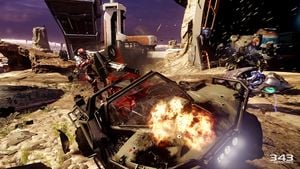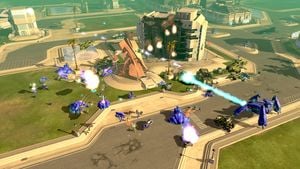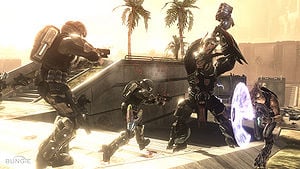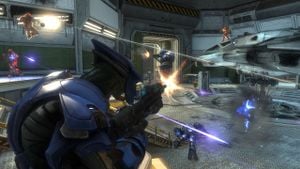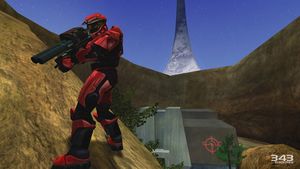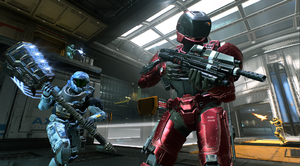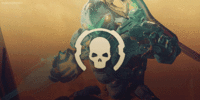Multiplayer
From Halopedia, the Halo wiki
| There is more information available on this subject at Multiplayer on the English Wikipedia. |
- "Two men enter. The better man leaves. The lesser man is respawning. And that's Halo."
- — Luke Smith
Multiplayer is a feature of a video game allowing more than one person to play a game at the same time in a non-campaign setting. Multiplayer can be conducted using split-screen (with the exception of Halo 5: Guardians), System Link, or online. In the Halo games, multiplayer has been regarded as a core element of the game's design and an important part of the success of the Halo franchise.
Since Halo 4, multiplayer has been integrated into the Halo series canon as a Spartan training simulation known as War Games.[1]
Background
Multiplayer matches in Halo tend to focus on the completion of an objective, with the objective in question being determined by the gametype being used. Players use weapons, equipment, and vehicles to advance toward the objective while inhibiting their opponents' progress. These items are commonly used, as one might expect, to score kills. Scoring kills can be helpful even in non-deathmatch games, as a killed opponent will often respawn away from their objective and without their preferred weapons.
In more recent games in the series (from Halo 3 onwards), modes of play are accessed through lobbies. While in lobbies, players can organize themselves into groups called 'parties'.[Note 1] Each party has one party leader, who controls the lobby that the party will play in and the settings that they will use. Party leaders can leave the party open (allowing other players to join at any time) or restrict it to an invite-only status (other players must be invited by members of the party in order to join). They can also promote another player in the party to the party leader.
Though some Halo games with support for online multiplayer have used (user-established) dedicated servers, most games in the franchise rely on a distributed networking model. In such a model, the players' consoles connect to each other directly, with one console acting as a server.
As is the case with virtually every competitive activity in human society, people have tried to cheat while playing Halo. Numerous arguably-unfair practices, such as camping, team-killing, and the Noob Combo, are used for the same reason. A multiplayer map can take as many as sixteen players.
Profiles
Each Halo first-person shooter allows players to create profiles, which are used to store information about players. Halo profiles store both a player's game settings and some customized visual details to distinguish the player. In Halo games made for Xbox Live, profiles are bound to gamertags; all gameplay is conducted with a profile, and players without gamertags are granted temporary profiles for the duration of their session.
The profile creator in Halo: Combat Evolved was very basic. Players had the ability to create a unique name, customize their armor color, and change the game controls and settings. Halo PC's settings were more intricate, including various sound and video settings as well as the ability to create custom control schemes (as opposed to picking preset control schemes).
With the addition of online multiplayer through Xbox LIVE, the profile creator in Halo 2 was redesigned and altered. Halo 2 introduced additional armor colors and the ability for a player to use two colors for their armor. Major additions included the ability to play as a Sangheili in multiplayer and the additions were notable for allowing players to identify teammates at a glance—a sharp contrast to the unmarked waypoints shown in Halo: Combat Evolved.
The updated profile creator in Halo 3 kept those settings and added more. Players could create a Service Tag consisting of a letter and two numbers; Service Tags are now shown over waypoints instead of Emblems. Additional Emblem designs, colors, and features were added. Bungie also added a gender option, which changes the player's voice. The most notable addition, however, was the armor permutations, which allows players to change the models used for their helmets, shoulders, and chestplates.
Halo: Combat Evolved

The multiplayer component of the Halo: Combat Evolved Xbox version was limited to split-screen and System Link play. Five core gametypes existed: Slayer, Oddball, Capture The Flag, King of the Hill, and Race. Various stock variants with altered settings existed, and players could create their own.
Though the game did not support online multiplayer, network tunneling programs, such as XBConnect and XLink Kai, could be used to coerce the game into running online. However, the game tends to freeze and stutter while it works to keep things synchronized—today's internet connection speeds come nowhere close to the 100 megabit connection that the game expects.
Halo PC
The PC version supports online multiplayer, and can run games with custom gametypes and up to sixteen players. Six additional maps were also added to the game: Danger Canyon, Death Island, Gephyrophobia, Ice Fields, Infinity, and Timberland. Two additional weapons—the Flamethrower and the Fuel Rod Gun—became usable in the PC version as well.
Players can host both listen servers and dedicated servers. A server browser, provided by GameSpy, comes with the game, though players can also use a LAN browser to find servers. (Alternatively, the IP address or domain name of a server can be accessed directly.) Unfortunately, the game lacks any kind of stat tracking, standardized rules, banlists, or cheat detection past what server administrators provide; this complicates competitive organization and the prevention of cheating and griefing.
Halo Custom Edition
Halo Custom Edition, a multiplayer-only expansion of Halo PC, allowed players to run user-created maps and gametypes online. Such maps could be created using the Halo Editing Kit. Amongst these maps were a number of Halo 2-based maps, such as Zanzibar and Coagulation.[2][3] In addition, there are a vast number of non-canon maps set in Halo-inspired locations using only Halo assets, as well as many other maps which incorporate custom weapons, vehicles, locations, and player models.
Halo 2
- "They say all good things must come to an end. Well, we say that totally sucks! Thanks for treating our old gal right for all these years. And thanks a million for playing. <3,"
- — Bungie's farewell message
Halo 2's multiplayer functionality was completely redesigned to work with Xbox Live. Matchmaking allowed players to search for games in a variety of different playlists, such as Team Objective, Team Doubles, and Rumble Pit; players could find each other quickly, relatively anonymously, and without having to sort through their friends list. Players could also create and host their own Custom Games, and could invite other players to join them. The lobby system was also introduced; each form of multiplayer was given a lobby, so that players in a party could stick together after a match.
Putting Microsoft's Trueskill system to use, Bungie employed a ranking system that displayed a level (1-50) based on how well a player played in a particular playlist. Rankings were for individual playlists, and players who would continually win games in a certain playlist would rank up in that playlist. Bungie also split their multiplayer component into two major categories; ranked and un-ranked. While the ranked playlists offered players a chance to display skill, the un-ranked playlists were more social and relaxed, and allowed guests.
Halo 2 introduced the concept of awarding medals to players for various accomplishments during a match, such as multikills and sprees, as well as kills caused by certain weapons or vehicles. Medals are shown on Bungie.net's game viewers and in the Postgame Carnage Report. The Race gametype was removed due to a lack of popularity, and three new gametypes were introduced: Juggernaut, Assault, and Territories.
Since Microsoft discontinued Xbox LIVE support for the original Xbox on April 15, 2010, Halo 2 is no longer playable online. Due to Xbox LIVE for original Xbox games being disabled, a glitch has occurred in which users that possess DLC for Halo 2 are no longer capable of accessing it due to there being no existing connection in order to confirm and verify the purchase of the said DLC tiles; rendering them useless.
Halo 2 Vista
Halo 2 for Windows Vista utilized the Games for Windows LIVE service, but in a much different way from its Xbox counterpart. Rank-based Matchmaking was done away with, and, like its predecessor, Halo: Combat Evolved for PC, Halo 2 Vista added a server browser and allowed players to join games in progress. Servers ran a map cycle in the form of a playlist, where players would congregate in a lobby until the game starts, play the game, then go back to the lobby to review the Postgame Carnage Report and chat with other players until the next round started. LIVE Gold users could filter out servers not matching their interests, and quickly jump right into a game in progress by selecting a "Quick Match" option.
Halo 2 Vista did not feature Tombstone or Desolation. It instead offered District and Uplift, as well as the Halo 2 Map Editor, which allowed players to create custom Halo 2 Vista maps.
On July 27, 2008, the Gold-only limitations were removed, and all LIVE subscribers, regardless of membership level, could use all aspects of Halo 2 Vista multiplayer without restriction.[4]
Halo 3
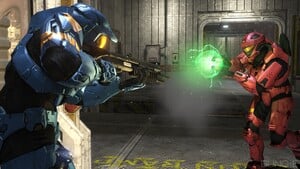
Halo 3 introduced many new features to its multiplayer experience. Custom gametypes were given a whole new level of customization. Numerous settings, including a player's weight, were added. Spawn-time specific attributes could also be assigned; these attributes would last for a set number of seconds after a player spawns. This can be helpful for preventing spawnkilling. Two new core gametypes, VIP and Infection, were added.
Matchmaking was enhanced with many under-the-hood features to help get better player matches and reduce wait time. Two very useful features were added to the pre-game and post-game lobbies: in the former, players can vote to veto gametype-map combinations that nobody wanted to play; in the latter, players could "Party Up", so that players could continue playing together. The number of Medals increased drastically, including Medals for killing sprees with certain weapons, the Linktacular medal for getting matched with nothing but Bungie.net members, and the Steaktacular medal for winning a Slayer game by more than twenty points.
Finally, custom games were enhanced with the addition of Forge, a multiplayer map editor. Forge allowed players to manipulate various objects in maps. Altered object configurations could be saved as map variants and uploaded to a player's File Share. Glitches have been used to create particularly interesting map variants.
Ranking, EXP, and Skill
The ranking system introduced in Halo 2 was redone in order to balance out Matchmaking even further. The Trueskill system was still present on ranked playlists, but a new 'Experience (EXP)' stat was added to player profiles. Whenever a player plays a match without quitting and is in the top position or on the winning team, the player gains 1 EXP. Players who enter a playlist, but disconnect or quit early lose 1 EXP for desertion. Players who end up in a losing position or team do not gain or lose EXP. In theory, this helps with player matching and balancing by finding players who have been playing the game as much as the player has based on his EXP level.
Auto Update 2, which went live on August 1, 2008, added another layer of EXP to further balance out players. EXP is now tracked for each individual playlist, in addition to the player's Trueskill ranks and overall EXP. When in a Matchmaking playlist, players' Trueskill ranks (if a ranked playlist) and playlist-specific EXP are shown. When in a custom game, or viewing a player's details or service record, overall EXP is shown.[5]
Halo Wars
- Main article: Skirmish
Halo Wars allows players to battle in a variety of multiplayer arenas. Players can choose from three different commanders from both UNSC leaders (Captain Cutter, Sergeant Forge, or Professor Anders) and the Covenant leaders (the Arbiter Ripa 'Moramee, the Avitus, or the Prophet of Regret). Each leader possesses various abilities and exclusive units, providing incentives for certain characters on certain maps, rather than being purely aesthetic.
Multiplayer matches are limited to six players and may be organized in evenly-matched teams. Computer-controlled players may be used. Halo Wars also uses a ranking system similar to that of Halo 3 aesthetically, but the ranks are assigned based on players' scores in completed games, acting as a method of progression over that of a measure of skill. The game uses a trueskill system to find matches, ranging from 1 to 50.
The Halo Wars Strategic Options DLC pack gives players three more skirmish game modes to play for 800 Microsoft Points. The game types include Keepaway, Tug of War, and Reinforcements. A DLC pack called the Historic Battle map pack introduced four new maps for the same price.
Halo 3: ODST
- Main article: Firefight
Halo 3: ODST features a new Firefight mode. In Firefight, up to four players fight against waves of Covenant forces and try to survive as long as possible with a set amount of lives, while the difficulty gradually increases by changing the currently active Skulls. Firefight lacks any sort of matchmaking system or game browser; players must join lobbies through the Xbox Live guide (recent players with open parties, friends lists, invites), via System Link, or all play locally, on the same console.
Halo 3: ODST also contains the Halo 3: Mythic disc, which is a multiplayer-only version of Halo 3.
Halo: Reach
Halo: Reach has a collection of new multiplayer features. Players are able to view in-depth statistics for their friends' matches. The veto system used in Halo 3's Matchmaking is replaced by a voting system, whereby players are given an assortment of three gametypes and maps, as well as the option to vote 'none of the above' to be given a new list of three gametypes. The gametype with the most votes wins.
New game modes include Arena, Headhunter, Stockpile, and Invasion, with Race making its first appearance since Combat Evolved. Arena is a ranked, skill-based playlist in month-long seasons, of which there are five divisions: Onyx, Gold, Silver, Bronze, and Iron. Ranked and social playlists have returned as well. In Halo: Reach, the 'Party Up' system is now the 'Opt-Out' system. Players will automatically be placed together but they have the option to leave. The player can also set advanced settings for finding matches. If, for example, the player relies heavily on teamwork or in-game chat, the player can choose to find people with similar settings.
Queue-joining is a brand new feature in Halo: Reach. This allows the player to join their friend automatically after they finish playing their match.
Firefight is available to play in Halo: Reach with a matchmaking feature. Additionally, players are able to customize every aspect of Firefight, from what type of enemies they fight to what type of weapons appear on the map.
Halo 4
Referred to as Infinity, the multiplayer component of Halo 4 consists of War Games, the competitive multiplayer mode, and Spartan Ops, the episodic cooperative campaign. The multiplayer features a canon explanation of why the red and blue teams compete with one another: the Spartans are actually training against each other in simulations aboard the UNSC Infinity. The player models are SPARTAN-IV soldiers with customizable armor.[6]
Of the gametypes featured in Reach, only Slayer, Oddball, Capture the Flag, and King of the Hill return. Infection has been replaced by a successor, Flood. Four new gametypes make their debut: Dominion, Regicide, Extraction, and Ricochet. Although Assault is discontinued its progeny, Grifball, returns as its own unique gametype, now with elements of Oddball incorporated in its mechanics. Ricochet in turn is also very similar to Assault.
Matchmaking features a voting system similar to Reach's, however it no longer includes the "none of the above" option, and players cannot change their vote once they have placed it. The most significant change to matchmaking is that players can now join matches in progress. Players joining matchmaking may find themselves entering games already in progress; matches which have players leave or disconnect will have their numbers supplemented by new players.
The player progression system is more extensive, allowing players to choose between various modifications which have an effect on gameplay, in addition to aesthetic armor permutations similar to the prior games.[7] Players are able to customize their loadouts,[8] being able to choose between various armor abilities as well as new customizable features, known as Support Upgrades and Tactical Packages. Multiplayer gameplay is more fast-paced than in the prior games. Weapon pickups on maps are marked on the player's heads-up display,[9] and players are able to call in ordnance drops, containing power-ups or weapons, during matches.[7] Power-ups available in Infinity Slayer include Overshield, Damage Boost, and Speed Boost.[10]
Halo: The Master Chief Collection
Halo: The Master Chief Collection allows players to play Halo: Reach, Halo: Combat Evolved, Halo 2, Halo 3, Halo 4, and Halo 2: Anniversary matchmaking and custom games. The game features a unified user interface, allowing for the player to drop into a playlist featuring Halo: Combat Evolved through to Halo 4, to find a game across the four title's maps and gametype setups. Playlists for individual games were also set up, and featured a ranking system akin to Halo 2, whereas Halo 3 and Halo 4's progression and ranking systems were dropped entirely.
With the release of 2018's overhaul update for The Master Chief Collection, a new matchmaking function called the "Match Composer" effectively replaced social playlists. The Match Composer allows the player to choose a game preset to search for games in, some of which include Slayer, Infection, or Objective. Conversely, the player can choose individual games, gametypes, and player counts to search for, meaning that rather than searching solely for Halo 2: Anniversary in a single playlist bound with multiple potentially unwanted gametypes, one could search for Anniversary, and Halo 4 specifically, while limiting the gametype selection to just Capture the Flag.
Like earlier games' multiplayer customization includes nameplates, service tags, armor permutations for both Spartans and Sangheili, and emblems. New features to customization include clan tags and in-game avatars.[11] Clan tags are 15 character tags seen on a player's nameplate, and avatars function in the same vein as Halo 4's stances did, showcasing a character from the franchise.
With the release of the remaster for Halo: Reach, 343 Industries introduced a new progression system into The Master Chief Collection. XP gains were based on medals gained in the match, and ranking up would allow players to unlock "Season points" that could then be used for the unlock system, enabling them to progress through tiers akin to the popularized "battle passes" of other titles like Fortnite and Call of Duty. The first season was dubbed "Noble".
Halo 2: Anniversary
Halo 2: Anniversary multiplayer is a highly modified version of the Halo 4 experience, having been developed on the same engine. Large tweaks to the prior title were made, including the re-addition of descoping, and the removal of sprint and flinch. Six maps were remade for the game, and Certain Affinity president Max Hoberman, one of the multiplayer design leads on the original Halo 2, helped 343 Industries design and create the remastered multiplayer component.[12] Many of the added features in the remastered maps were proposed for the original game but ended up being cut; thus, 343 Industries considers the remastered component a "Director's Cut" of sorts.[13]
The developers' stated goals for the remastered maps were to expand upon the core Halo 2 experience, create the definitive version of each of the remastered maps, and to approach the remastering as more of an upgrade than a remake. Multiple aspects of the sandbox were tweaked to both improve and "modernize" the gameplay, although the goal is to remain faithful to the original experience. Some of these improvements include a boost to player speed, making the magnum more powerful and the addition of the assault rifle as a mid-range weapon option, something the developers found lacking in the original.[13] The silenced SMG has also been added along with the newly introduced M274-M Gungoose.[13]
As an added feature, players are able to choose their weapon set upon spawning, similar to the loadout system in Halo: Reach. According to Max Hoberman, this feature was originally designed for Halo 2 but was ultimately cut. Hoberman hesitated to call the weapon sets "loadouts" and underscored that the system is designed to be more evenly balanced; e.g. Lockdown's weapon sets include a choice between the SMG, Okarda'phaa-pattern plasma rifle and magnum. The human weapon sets equip the player with two frag grenades while the Covenant ones have the player spawn with Anskum-pattern plasma grenades.[14] Ultimately, the game would mostly utilize an equal starts setup based around one weapon set.
Though most of the map geometry—including "skill jumps"—remain intact, the remastered maps contain a number of gameplay tweaks (such as additional cover) along with new "dynamic features", some of which Max Hoberman proposed to be added in the original Halo 2.[13] These include the addition of a large energy shield in the center of Zenith, the remake of Ascension, which can be triggered by three panels across the map,[15] and three stalactites which can be dropped on players on Lockdown, the remake of Lockout. Most of these new features can be disabled via Forge for an experience closer to the original game.[16]
Other additions to the remastered multiplayer include the name of the segment of the map that the player is currently in being displayed near the motion sensor as in Halo: Reach. Gametypes such as Infection, Race, Ricochet and Team SWAT have been added to the remastered multiplayer.
Halo 5: Guardians

Following in the footsteps of Halo 4, Halo 5: Guardians multiplayer component consisted of Arena, consisting of 4v4 to 8v8 activities, and Warzone, which are 12v12 games. Initially, only Slayer and Capture the Flag returned for Halo 5, with many being left out upon the game's launch. Eventually, through the game's monthly updates, many gametypes, including ball-based gamemodes like Assault and Grifball returned, as did King of the Hill, Oddball, Race and Infection, which was more in line with the original first two incarnations of the gametype, than Halo 4's Flood. Along with Slayer and Capture the flag there were 4 new game modes; Breakout, Strongholds, Warzone and Warzone Assault.
Guardians' matchmaking system dropped the voting and veto system brought into the series by Reach and Halo 4, and instead opted for an automatic queue, where the gametype and map are chosen by the game over the lobby. Join in progress has been removed for ranked gametypes, whereas social gametypes like Warzone and Warzone Assault feature it.
343 Industries also refined the polarizing armor abilities, altering them from one-note abilities that varied by player, to a clearly defined set of abilities known as Spartan abilities. These include Thruster pack, Ground Pound, Spartan Charge, Clamber, Slide, Smart Scope, Stabilizer, and the returning Sprint ability. All of these abilities are native to every player, over being chosen individual traits. Additionally, loadouts were removed from the game in any capacity, with an emphasis being placed on Halo's traditional equal starts.
In 2016, 343 Industries added a "Customs Browser" to Halo 5, enabling users to set up and search for custom games with other players in a similar manner to The Master Chief Collection's then unimplemented Match Composer.
Halo Wars 2
Halo Wars 2 multiplayer is largely similar to Halo Wars, taking its predecessor's gameplay and refining it. Like Halo Wars, leaders are able to be chosen prior to the game's start, with each character having distinct units and powers. Halo Wars 2 takes this a step further with its leader power wheel, which is a selection of 10 powers that vary by leader, unlike Halo Wars which had only one distinct ability per leader. As more leaders were released in DLC packs, more powers became available over time.
Halo Wars 2 features the same player count as the previous title, being a 1v1, 2v2 or 3v3 affair, with no free for all gametype present.
The prior progression system of Halo Wars was revamped, featuring a new rank 1 to 100 setup. A rank based on performance does exist, with a ranking system identical to Halo 5: Guardians being in effect for many playlists within the game.
Halo Infinite
Halo Infinite is the first multiplayer to be free to play. Like Halo 5: Guardians Halo Infinite multiplayer focuses on equal starts arena gameplay and features an automatic queue for map selection. Spartan abilities have been removed in favor of a refined equipment system. Infinite is the first first-person shooter multiplayer to feature bots in multiplayer, with bot slayer being an ideal testing ground for new players. If a player quits or disconnects in a match they will be replaced by a bot, though the same or another player can replace the bot and this does not apply to BTB or Ranked. New modes in Infinite include Total Control, Attrition, a refined Stockpile, and Last Spartan Standing.
Trivia
- The maximum number of players that can play the original Halo trilogy in multiplayer is 16.
- In Halo 3, Bungie offers a "Double EXP Weekend" playlist making it easier for players to level up during weekends.
- In Halo 3, Bungie offers a "7 on the 7th" playlist dedicated to getting achievements based on DLC maps around the 7th of every month.
- During the last days of the Xbox LIVE service for the original console for Halo 2, the "Did you know?" box in the search screen of the matchmaking section displayed messages, predominately in a comical style about Halo 2 features and exploits.
- The multiplayer announcer is voiced by Jeff Steitzer.
Gallery
Notes
- ^ In-game parties are not the same as Xbox Live Parties. In-game parties are groups of people playing together whereas Xbox Live Parties are groups of people using the voice chat to communicate.
Sources
- ^ Halowaypoint.com: Canon Fodder 3-21-15 (Retrieved on Mar 21, 2015) [archive]
- ^ Hce.halomaps.org: Halo Custom Edition: H2 Zanzibar Updated (Retrieved on Jul 23, 2005) [archive]
- ^ Hce.halomaps.org: Halo Custom Edition: Z Coagulation H2 pb2 (Retrieved on Aug 13, 2007) [archive]
- ^ Developmag.com: Games for Windows Live now free to developers (Retrieved on Jun 19, 2017) [archive]
- ^ Bungie.net: Bungie Weekly Update: 8/01/08 (Retrieved on Aug 1, 2008) [archive]
- ^ YouTube: Making Halo 4: First Look
- ^ a b Halo 4 Official Site: GAMEPLAY
- ^ Gamefront.com: Halo 4 Demo Report
- ^ Venturebeat.com: 11 new things we’ve learned about Halo 4 (with video)
- ^ Halo Waypoint: The Halo Bulletin: 7.6.12
- ^ Team Beyond.net: Halo: The Master Chief Collection Customization
- ^ YouTube: Halo: The Master Chief Collection Dev Panel - SDCC 2014
- ^ a b c d YouTube: RTX 2014 - 343 Industries panel
- ^ IGN.com: Get to Know Halo: The Master Chief Collection's 'Lockout' Remake, 'Lockdown' – IGN First
- ^ YouTube: Halo 2 Ascension Anniversary Walkthrough
- ^ YouTube: Halo and the Journey of the Master Chief- PAX Prime 2014
See also
